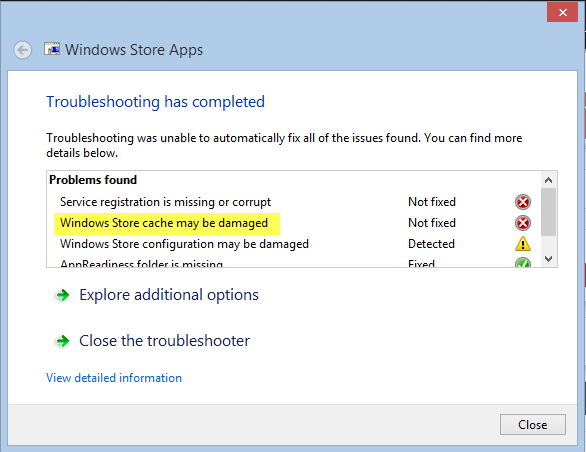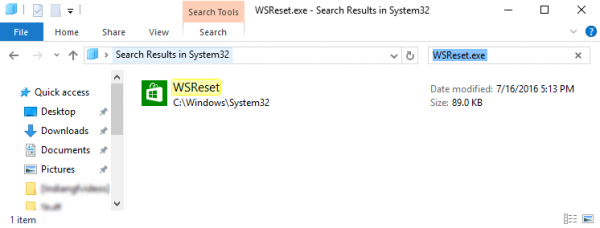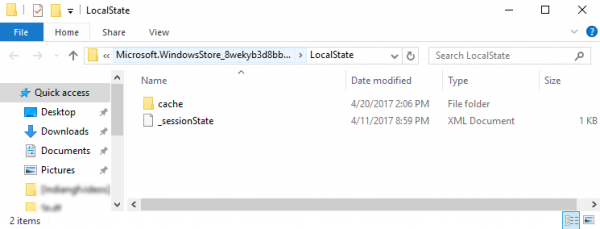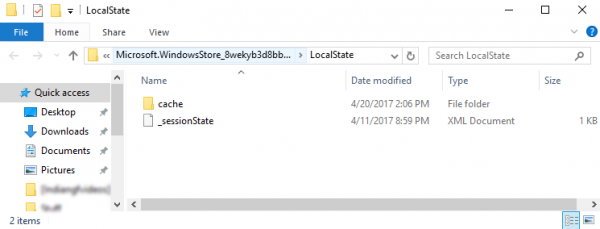The Windows Store is Microsoft’s marketplace for downloading apps. However, many times users may encounter one or the other problem in accessing and using the Store or the Apps. This post is related to resolving one such problem many users have very frequently encountered- that of a damaged Microsoft Store Cache. When you face issues when running Windows Store apps, the Windows Store Apps Troubleshooter is able to fix the problems usually. The troubleshooter scans your system to detect the problems that might prevent it from working properly on your Windows 11/10. The troubleshooter then tries to solve the problem automatically without necessitating any action from your end. But what if the troubleshooter itself gives a message – Windows Store Cache may be damaged!?
If you receive a Windows Store Cache may be damaged error after running Windows Store Apps Troubleshooter, you may have to reset the Windows Store as well as the cache folder in the App Directory.
Fix Windows Store Cache may be damaged

In the case of a damaged Windows Store Cache, the troubleshooter is helpful in just identifying the problem. Beyond that, it is not really of much use in resolving the issue. Thus, over here, the troubleshooter can only diagnose the problem, not treat it.
If you too have or are facing such difficulty with your Windows Store, you might want to try to follow one of these two solutions to manually fix the problem.
1] Reset Windows Store
To clear the Windows Store cache, open the Sytem32 folder, and look for the WSReset.exe. Right-click on it and select Run as administrator.

The application will then reset the Windows Store without changing any of your settings or installed apps. Windows will automatically open the Windows Store upon the reset operation getting completed. You should now be able to access and use the Windows Store properly.
2] Reset the cache folder in App Directory
Open File Explorer, copy-paste the following path in the explorer address bar and hit Enter:
C:\Users\<username>\AppData\Local\Packages\Microsoft.WindowsStore_8wekyb3d8bbwe\LocalState
Again, in case your Windows is installed on some other drive, replace ‘C’ above with the system root drive, followed by the name of your own user account. Also, replace the text <username> with the username associated with your account.

Now, in the LocalState folder, check whether the cache folder is present or not. If it is there, rename it to ‘cache.old’. After that, create a new empty folder and name it ‘cache’.

Once you are done with the above step, close the File Explorer and reboot your system. After the reboot, run the Windows Store Apps troubleshooter again. This time it will not only detect the problem but also automatically resolve it.
Restart your system once more and try opening the Microsoft Store. This method should work even if you have a local account.
See this post if you receive a Service registration is missing or corrupt error message.
It doesn’t work.
The same message appear again and again…
Windows Store Cache may be damaged
I had a similar issue with the last version of Windows 10. Many hours of soultion trying including 8 seperate attempts by Microsft Help techos did not resolve.
Only way out. Complete reinstal from an external media source.
If you do this once you have your machine and all your programs up and running as you wish> Instal Macrium Reflect (free) and create a mirror back up to an external drive. Then if issues happen you can restore your machine to a known working version. This does not affect any programms, apps or files with all being restored exactly as was. PS Create ne mirror back ups monthly (delete the oldest after a while).
Hi.
I’m experimented as I’m a computer engineer.
I have no bug and I have reinstalled W1 two weeks ago.
What I say is tha many users get the error message and this tip doesn’t fix it.
It doesn’t matter, the Windos Store works fine.
But this tutorial doesn’t.
@+
Did not work,,same message after adding a Cache folder where there was none,,and running the troubleshooter again,,this is why ive come to really dislike windows 10,,this kind of nonsense,,ive seen around 5 different fixes for this issue and that makes it even more frustrating,,I dislike having to reinstall windows 10 more than any other version.
Computer Engineer huh ? Well did they teach you how to spell ? Guess not. Windows store is not working fine for those searching for answers,,your post is not helpful at all, it matters to some, By the way there is no Windos store genius, try again experimented person,,,LoL
Thank you sir! Solved my issue!!!
Also, it solved connectivity problems that # Slack app had!
Bravo!
There is extra JASON file with cache folder and _Sessionstate
Doesn’t work. Reset does nothing in option 1 above. Just gives me a black .exe screen.
telling someone it works on their pc without explaining why or how isnt helpful, furthermore the bad translation above compounds that even more, as a computer engineer the poster should know that better than most. my comment wasn’t directed at you but more by the lack of effort put into a post by someone claiming to be a professional.
This doesn’t work for one of my older systems
Worked for me! Thanks.
It’s exactly what I said.
It doesn’t work, bu it is a minor bug for me.
You’re a funny guy… I wrote Engineer instead of engineer, right.
You write Windos store…
Do you know what is a typing error ?
So keep you naughty remarks for yourself ! rofl
This unfortunately did not work for me either. I got the same message that Windows Store Cache may be damaged.
Me neither. Cannot upgrade to the Creator version as it is impossible. Can only do it over public WiFi and it is impossible as takes 12 hours to install. Microsoft Tip: Make huge upgrades available on DVD.
Only option is hard reset of entire system (or get another laptop hybrid and use SP4 and Microsoft reputation for target practice).
There was no folder in there just one file MBRDNSCache.json
I have the same problem but my computer runs fine. I wouldn’t have even known if I didn’t troubleshoot the store.
Microsoft engineers must have Apple computers at home, that’s why they aren’t looking for solutions to these kind of problems.
LoL nope guess not,,dont take yourself too seriously, when you get as old as me you will understand the value the value of a little humor now and then,, lol naughty remarks.
I would check out your filenames under quick access if I were you [indiangfvideos]? Not the sort of thing I would want anyone seeing if it were me ;)
But thanks for the tutorial.
“2] Now, in the LocalState folder, check whether the cache folder is present or not. If it is there, rename it ‘cache.old’. After that, create a new folder and name it ‘cache’. In case the cache folder is not there by default, just create an empty new folder and name it ‘cache’.
Next, create a new folder and name it ‘cache’. In case the cache folder is not there by default, just create an empty new folder and name it ‘cache’.”
So by the end of step two, if the “cache” folder already existed, we should then have a folder named “cache.old” as well as two folders named “cache?” And if we did not have a preexisting folder named “cache,” by the end of this step, we should have three folders named “cache?” Geeze, if I only had that much cache in real life!
“I have a strong suspicion that English is not your native language” > Smart! You guessed it right. My mother tongue is Marathi. Had you even ever heard of it? Guess not.
“Now, in the LocalState folder, check whether the cache folder is present or not. If it is there, rename it ‘cache.old’. After that, create a new folder and name it ‘cache’. In case the cache folder is not there by default, just create an empty new folder and name it ‘cache’… etc” > You were dumb enough to not realize that I had made a mistake and said the same thing more than once.
Thanks for pointing out the mistake though! And yes, you have yourself a nice day! :)
i could not find “Microsoft.WindowsStore_8wekyb3d8bbwe” help me